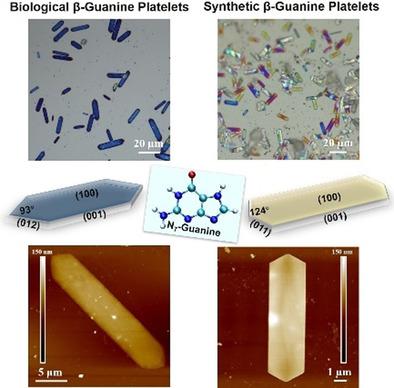当前位置:
X-MOL 学术
›
Chem. Eur. J.
›
论文详情
Our official English website, www.x-mol.net, welcomes your
feedback! (Note: you will need to create a separate account there.)
Synthesis of bio-inspired guanine microplatelets: morphological and crystallographic control.
Chemistry - A European Journal ( IF 3.9 ) Pub Date : 2020-09-04 , DOI: 10.1002/chem.202003156 Fenghua Chen 1, 2, 3 , Yanan Liu 1 , Ling Li 4 , Limin Qi 2 , Yurong Ma 1
Chemistry - A European Journal ( IF 3.9 ) Pub Date : 2020-09-04 , DOI: 10.1002/chem.202003156 Fenghua Chen 1, 2, 3 , Yanan Liu 1 , Ling Li 4 , Limin Qi 2 , Yurong Ma 1
Affiliation

|
β‐Phase anhydrous guanine (β‐AG) crystals are one of the most widespread organic crystals to construct optical structures in organisms. Currently, no synthetic method is available that allows for producing guanine crystals with similar control in size, morphology, and crystallography as in biological ones. Herein, a facile one‐step synthesis route to fabricate bio‐inspired guanine microplatelets with (100) exposing planes in almost pure β‐phase is reported. The synthesis is based on a precipitation process of a guanine sodium hydroxide solution in formamide with poly(1‐vinylpyrrolidone‐co‐vinyl acetate) as a morphological additive. Due to their uniform size (ca. 20 μm) and thickness (ca. 110 nm), the crystals represent the first synthetic guanine microplatelets that exhibit strong structural coloration and pearlescent lusters. Moreover, this synthesis route was utilized as a model system to investigate the effects of guanine analogues, including uric acid, hypoxanthine, xanthine, adenine, and guanosine, during the crystallization process. Our results indicate that the introduction of guanine analogues not only can reduce the required synthesis temperature but also provide a versatile control in crystal morphology and polymorph selection between the α‐phase AG (α‐AG) and β‐AG. Turbidity experiments show that the β‐AG microplatelets are formed with a fast precipitation rate in comparison to α‐AG, suggesting that the formation of β‐AG crystals follows a kinetically driven process.
中文翻译:

生物启发的鸟嘌呤微血小板的合成:形态学和晶体学控制。
β-相无水鸟嘌呤(β-AG)晶体是在生物体内构建光学结构的最广泛的有机晶体之一。目前,尚无合成方法可用于生产鸟嘌呤晶体,其尺寸,形态和晶体学控制与生物学方法相似。本文报道了一种简便的一步合成路线,该路线可制造出具有仿生的鸟嘌呤微血小板,其具有在几乎纯的β相中具有(100)个暴露平面的鸟嘌呤微血小板。合成基于鸟嘌呤氢氧化钠溶液在甲酰胺中的沉淀过程,其中聚(1-乙烯基吡咯烷酮-乙酸乙烯酯)为形态添加剂。由于其均一的尺寸(约20μm)和厚度(约110 nm),该晶体代表了第一个合成的鸟嘌呤微片,该微片呈现出强烈的结构着色和珠光光泽。此外,该合成途径被用作模型系统,以研究鸟嘌呤类似物在结晶过程中的作用,包括尿酸,次黄嘌呤,黄嘌呤,腺嘌呤和鸟嘌呤。我们的结果表明,引入鸟嘌呤类似物不仅可以降低所需的合成温度,而且还可以提供对α相AG(α‐AG)和β‐AG之间晶体形态和多晶型选择的通用控制。浊度实验表明,与α-AG相比,β-AG微片的沉淀速率快,这表明β-AG晶体的形成遵循动力学驱动的过程。我们的结果表明,引入鸟嘌呤类似物不仅可以降低所需的合成温度,而且还可以提供对α相AG(α‐AG)和β‐AG之间晶体形态和多晶型选择的通用控制。浊度实验表明,与α-AG相比,β-AG微片的沉淀速率快,这表明β-AG晶体的形成遵循动力学驱动的过程。我们的结果表明,引入鸟嘌呤类似物不仅可以降低所需的合成温度,而且还可以提供对α相AG(α‐AG)和β‐AG之间晶体形态和多晶型选择的通用控制。浊度实验表明,与α-AG相比,β-AG微片的沉淀速率快,这表明β-AG晶体的形成遵循动力学驱动的过程。
更新日期:2020-09-04
中文翻译:

生物启发的鸟嘌呤微血小板的合成:形态学和晶体学控制。
β-相无水鸟嘌呤(β-AG)晶体是在生物体内构建光学结构的最广泛的有机晶体之一。目前,尚无合成方法可用于生产鸟嘌呤晶体,其尺寸,形态和晶体学控制与生物学方法相似。本文报道了一种简便的一步合成路线,该路线可制造出具有仿生的鸟嘌呤微血小板,其具有在几乎纯的β相中具有(100)个暴露平面的鸟嘌呤微血小板。合成基于鸟嘌呤氢氧化钠溶液在甲酰胺中的沉淀过程,其中聚(1-乙烯基吡咯烷酮-乙酸乙烯酯)为形态添加剂。由于其均一的尺寸(约20μm)和厚度(约110 nm),该晶体代表了第一个合成的鸟嘌呤微片,该微片呈现出强烈的结构着色和珠光光泽。此外,该合成途径被用作模型系统,以研究鸟嘌呤类似物在结晶过程中的作用,包括尿酸,次黄嘌呤,黄嘌呤,腺嘌呤和鸟嘌呤。我们的结果表明,引入鸟嘌呤类似物不仅可以降低所需的合成温度,而且还可以提供对α相AG(α‐AG)和β‐AG之间晶体形态和多晶型选择的通用控制。浊度实验表明,与α-AG相比,β-AG微片的沉淀速率快,这表明β-AG晶体的形成遵循动力学驱动的过程。我们的结果表明,引入鸟嘌呤类似物不仅可以降低所需的合成温度,而且还可以提供对α相AG(α‐AG)和β‐AG之间晶体形态和多晶型选择的通用控制。浊度实验表明,与α-AG相比,β-AG微片的沉淀速率快,这表明β-AG晶体的形成遵循动力学驱动的过程。我们的结果表明,引入鸟嘌呤类似物不仅可以降低所需的合成温度,而且还可以提供对α相AG(α‐AG)和β‐AG之间晶体形态和多晶型选择的通用控制。浊度实验表明,与α-AG相比,β-AG微片的沉淀速率快,这表明β-AG晶体的形成遵循动力学驱动的过程。















































 京公网安备 11010802027423号
京公网安备 11010802027423号